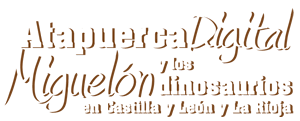Salas de los Infantes route
We can explore the Museo de los Dinosaurios
In addition to the visiting the historic town of Sala de los Infantes, we can explore the Museo de los Dinosaurios in Plaza Jesús Aparicio next to the City Hall. This museum features some models of fossils found nowhere else in the world: the gigantic Demandasaurus darwini dinosaur measuring 12 meters long and related to others from Africa and South America; Arcanosaurus ibericus, a lizard relative of the present-day "Komodo Dragon" and the Larachelus morla turtle. These unique models and the diversity of species represented in the museum indicates the special importance of the Museo de Dinosaurios collection in Salas de los Infantes.
The museum is complemented by a Sala de Arqueología (Archaeology Hall) featuring pieces from all the prehistoric and historic periods documented in the mountain region. It enables us to increase our knowledge of the different groups of people and cultures who left their mark on this area.
The Costalomo fossil track site is only four kilometers from Salas on the regional CL-117 road linking Salas de los Infantes with Bidones in Soria province. The road branches off and the entrance is easy to find. 239 fossil tracks are preserved there, dating back to the early Cretaceous period (125 million years ago). Its representations of the tracks in 3D, providing faithful reproductions of the dinosaurs' toes, are a unique contribution to the planet’s fossil record.
Various types of dinosaurs are represented at Costalomo; theropods are common, carnivorous dinosaurs; one of their trails contains a track 75 centimeters long, appropriate for a dinosaur 15 meters long. One fearsome predator that earned the name Atila (Attila), given him by paleontologists, could have been a member of the Spinosauridae family. Other groups found at the site include: ornithopods, herbivores or plant eaters; sauropods, vegetarian quadrupeds of enormous dimensions; and avian theropods, dinosaurs with feathers and the direct ancestors of birds.
Costalomo was part of a subtropical ecosystem, traversed by a great river that periodically overflowed its banks. The vegetation was composed of coniferous and bennettitales plants (the latter similar to present day cycads) as well as water and tree ferns. The fossils of these living beings from the Cretaceous period are exhibited at the Museo de Dinosaurios in Salas de los Infantes, together with a partial replica of the site and a life-size, 1-1 scale replica of a track.









